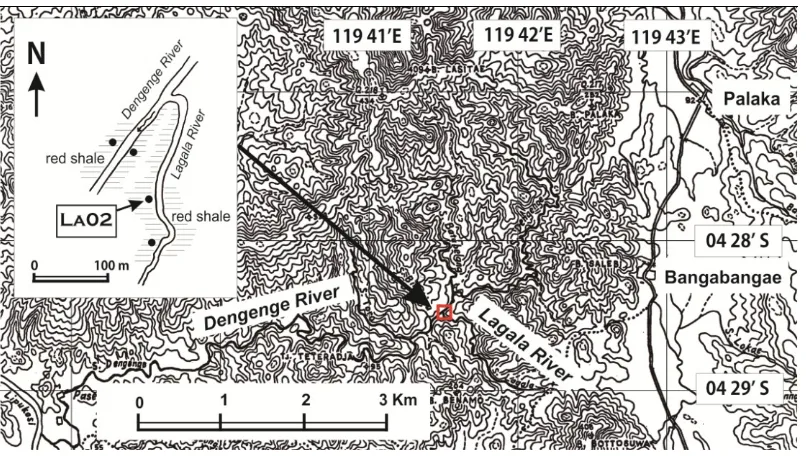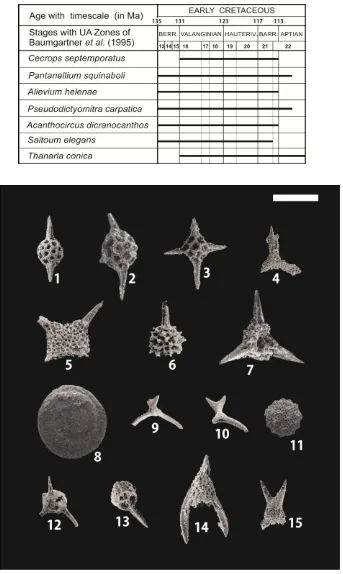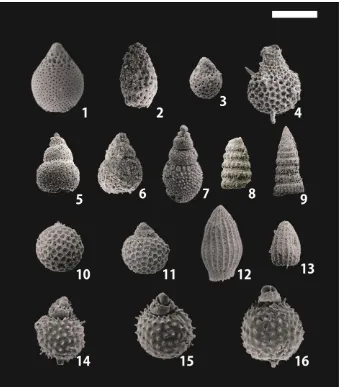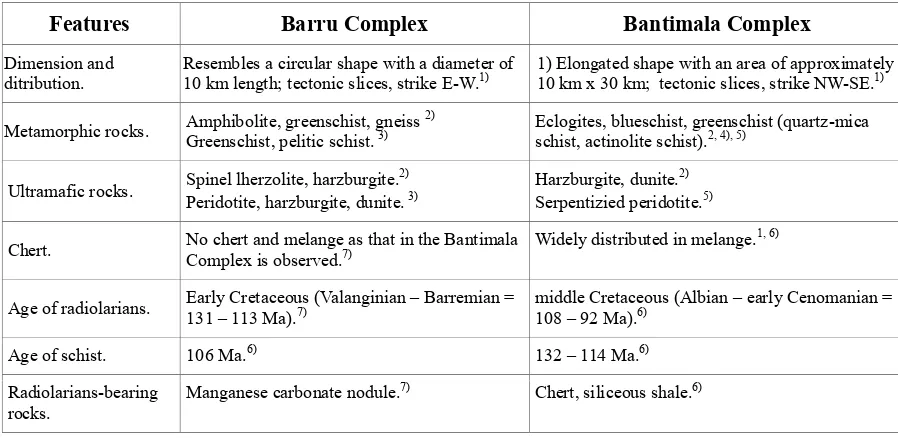©2013 Pusat Penelitian Geoteknologi Lembaga Ilmu Pengetahuan Indonesia
79 DOI :10.14203/risetgeotam2013.v23.71
EARLY CRETACEOUS RADIOLARIANS IN MANGANESE
CARBONATE NODULE FROM THE BARRU AREA, SOUTH
SULAWESI, INDONESIA.
Radiolaria Kapur Awal pada Nodul Mangan Karbonat dari Daerah
Barru Sulawesi Selatan, Indonesia
Munasri
ABSTRACT The Mesozoic basement complex in South Sulawesi, Indonesia, is exposed in two areas near Bantimala and Barru, known as the Bantimala Complex and the Barru Complex. The complexes consist of metamorphic, ultramafic and sedimentary rocks. Part of these rocks was chaotically mixed to form a mélange. Early Cretaceous (Valanginian to Barremian) radiolarians were extracted from manganese carbonate nodule embeded in dark reddish shale of the Barru Complex. Previously middle Cretaceous (late Albian to early Cenomanian) radiolarian assemblage was reported found in chert and siliceous shale of the Bantimala Complex.The hemipelagic dark reddish shale with manganese carbonate nodule of the Barru Complex are considered to have been deposited in Early Cretaceous time (Valanginian to Barremian) and accreted at the subduction trench during late Early Cretaceous (Aptian) time.Based on radiolarian data, it is considered that the Barru and Bantimala Complexes were not derived from single accretionary complex as previously regarded.
Keywords: Radiolaria, Manganese Carbonate, Early Cretaceous, Barru Complex, South Sulawesi.
ABSTRAK Komplek batuan dasar berumur
Mesozoikum di Sulawesi Selatan tersingkap di dua wilayah dekat Barru dan Bantimala, dan dikenal sebagai Komplek Barru dan Komplek Bantimala. Komplek ini mengandung komponen yang terdiri atas batuan-batuan metamorf, ultramafik, sedimen; dan sebagian dari batuan ini tercampur-aduk sebagai mélange. Fosil radiolaria berumur Kapur Awal (Valanginian – Barremian) telah diekstraksi dari batuan nodul mangan karbonat yang terbenam pada batuserpih merah dari Komplek Barru. Sebelumnya dilaporkan kumpulan fosil radiolaria berumur Kapur tengah (Albian – Cenomanian) terdapat pada batu rijang dan serpih di Komplek Bantimala. Endapan hemipelagik serpih merah dengan nodul mangan karbonat di Komplek Barru dianggap diendapkan pada zaman Kapur Awal dan terakresi pada parit subduksi selama masa akhir Kapur Awal (Aptian). Berdasarkan data radiolaria, Komplek Barru dan Komplek Bantimala bukan komplek batuan dasar yang berasal dari satu sistem komplek akresi yang sama, seperti anggapan sebelumnya.
Kata kunci: Radiolaria, nodul mangan karbonat, Kapur Awal, Komplek Barru, Sulawesi Selatan.
INTRODUCTION
Since the discovery of Mesozoic radiolarians in Rote Island, West Nusatenggara, was reported by Tan Sin Hok (1927), modern radiolarian research - using SEM tools - in Indonesia was just started in the 1990s. Radiolarian occurrences were reported mainly from Mesozoic strata (Okamoto
et al., 1994; Wakita et al., 1994a, 1994b, 1998; Sashida et al., 1996, 1999a, 1999b; and Jasin and Haile, 1996). All of these radiolarians were extracted from chert, siliceous shale or siliceous
________________________________
Naskah masuk : 16 Juli 2013 Naskah selesai revisi : 28 Oktober 2013 Naskah siap cetak : 07 November 2013 ____________________________________
Munasri
Pusat Penelitian Geoteknologi LIPI
80
Figure 1. Geologic map of Cretaceous Subduction Complex in South Sulawesi (simplified after Sukamto, 1982 and Wakita et al., 1994b).
mudstone. These rocks are suggested to represent pelagic and hemipelagic sedimentary rocks of the Indian Ocean floor that has been subducted and accreted to Southeast Asia/Sundaland continent. Besides in chert and siliceous shale, radiolarians are naturally deposited within the manganese carbonate rocks. However, up to now, there has been no published report of radiolarians in manganese carbonate rocks in Indonesia.
In Japan, the occurrences of radiolarians in manganese nodules - mostly of Jurassic in age - have been reported by several workers since the 1970s (e.g. Yao. 1972, 1979; Hattori, 1988; Arakawa, 1998; Hori and Wakita, 2006). Most of manganese nodules from the inland section in Japan contain abundant, diversified and well preserved radiolarians. These radiolarians were examined for the use of taxonomy, age determination, biochronology and their paleogeographic deposition.
This paper presents the first discovery of Early Cretaceous radiolarians in manganese carbonate nodule located near Barru, South Sulawesi. Fairly well-preserved radiolarians in manganese carbonate nodule from the Barru area are not as abundant and diverse as those in manganese nodules samples from Japan. However, some certain species of radiolarians from the Barru area enable to set the age of the assemblage.
GEOLOGIC SETTING
The Mesozoic basement complex in the South Arm of Sulawesi is exposed in two areas, near Bantimala and Barru, known as the Bantimala Complex and the Barru Complex respectively and separated each other within 30 km. The complexes consist of metamorphic, ultramafic and sedimentary rocks, which part of these rocks are chaotically mixed as mélange (Figure 1). Mélange of the Bantimala Complex includes clasts and blocks of chert, sandstone, basalt, limestone and schist, embedded within a sheared shale matrix; and no such typical mélange is observed in the Barru Complex. Of the two exposures, the larger (Bantimala Complex) is the better known. The detailed geology of the Bantimala Complex has been investigated by Sukamto (1975, 1978, 1982, 1986), Hasan (1991)
and Wakita et al. (1994b, 1996). Sukamto (1982) established that the older rocks, which unconformably overlain by Late Cretaceous Balangbaru Formation - flysch type sedimentary rocks, as a mass named the Bantimala Tectonic Complex. These older rocks are referred to which including the set of rocks in the Barru Complex and the Bantimala Complex. The complexes are surrounded with Tertiary and Quarternary sedimentary and volcanic rocks.
Wakita et al. (1994b) reported that the age of chert and shale in the Bantimala Complex is middle Cretaceous (late Albian to early Cenomanian). The age is determined by the presence of certain species of radiolarians including Holocryptocanium barbui, Thanarla conica, Archaeodictyomitra vulgaris,
Rhopalosyringium majuroensis, Pseudodictyo-mitra pseudomacrocephala and Stichomitra communis.
81 Figure 2. Locality map of manganese carbonate nodule.
Figure 3. Outcrop of manganese carbonate nodule (a) embedded in weathered reddish shale (b).
Figure 4. Microscopic feature of single rhodochrosite 'micronodule' in sample LA02 with radiate structure containing radiolarian skeleton. Scale bar = 500 m.
The sample locality can be approached by car from Barru to Bangabangae through Palaka. To reach the sample site from Bangabangae was done by traversing from upstream and along the tributary Lagala River. Manganese carbonate nodules are scattered and embedded in weathered dark reddish shale (Figure 3). The nodules range from 10– 20 cm in size. The outer surface is brownish-black in color, while the fresh inside part is gray. According to Hattori (1993), manganese nodules are originally rhodochrosite concretions (Figure 4) and the outer black parts are composed of opaque manganese such as manganite and manganese hydroxides. Within the geologic map of Sukamto (1982), the sample site is laid on the geologic unit of metamorphic rock.
The contact boundary of manganese carbonate nodules-bearing shale with underlying metamorphic rocks is not observed. No radiolarian is obtained in shale. Of four sample
points of manganese carbonate nodule, only sample LA02 contains radiolarians (see the procedure of extracting below).
MATERIAL AND METHODS
82
Table 1. List of radiolarians from sample LA02. Abundance codes are as follows, Rare: 1-2, Few: 3-5.
Radiolarian species Abun-
dance Figure
Pantanellium squinaboli (Tan Sin Hok) Few 5. 1, 2
Cecrops septmporatus (Parona) Few 5. 3
Patulibrachium sp? Rare 5. 4
Emiluvia sp. Rare 5. 5
Alieveum sp. Few 5. 6
Acaeniotyle sp. Rare 5. 7
Patelula sp. Rare 5. 8
Acanthocircus dicranocanthos (Squinabol) Few 5. 9, 10
Praeconocaryomma sp. Rare 5. 11
Saitoum elegans (De Wever) Few 5. 12, 13
Napora sp. Rare 5. 14
Katroma sp. Rare 5. 15
Theocoeys sp. Rare 6. 1
Eucyrtidium parviporum Tan Sin Hok Few 6. 2
Theocapsa laevis Tan Sin Hok Few 6. 3
Podobursa sp Rare 6. 4
Stichomitra doliolum Aita Few 6. 5. 6
Stichocapsa pseudodecora Tan Sin Hok Few 6. 7
Pseudodictyomitra lilyae (Tan Sin Hok) Rare 6. 8
Pseudodictyomitra carpatica (Lozyniak) Rare 6. 9
Gongylothorax verbeeki (Tan Sin Hok) Few 6. 10, 11
3. After acid in solution is removed, the residues are washed gently over a 250 mesh sieve with a spray of running water and dried in the oven.
4. Radiolarians then are observed under the scanning electron microscope.
Radiolarian species obtained from sample LA02 are listed in Table 1 with their abundance. These radiolarian pictures are illustrated in Figures 5 and 6.
RADIOLARIAN AGE ASSIGNMENT
The radiolarian assemblage obtained from manganese carbonate nodule of the Barru Complex includes some age diagnostic species for Early Cretaceous. The age of the radiolarian assemblage described here (Table 2) refers to radiolarian biostratigraphic study of Baumgartner
et al. (1995), Tumanda (1989), Aita and Okada (1986), Sanfilippo & Riedel (1985) and Pessagno (1977). Based on Unitary Assocition (UA) Zones of Baumgartner et al. (1995) the biostratigraphic range of diagnostic species from this study is included within UAZ 17 and UAZ 21 (late Valanginian to early Barremian). Tumanda (1989) established four Creataceous radiolarian assemblage zones for the Esashi Mountain area, Northern Hokkaido, Japan on the basis of the association of several characteristic species. One of them, the Staurosphaera septemporata
-Parvicingula usotanensis Assemblage Zone is define by the occurrence of characterisitic species of Staurosphaera septemporata = Cecrops septemporatus, Parvicingula boesii, P. usotanensis, Sethocapsa trachystraca, S. uterculus, Mirifusus mediodilatatus, Alievium helenae, Acaeniotyle diaphorogona, A. umbilicata, Acanthocircus dicranocanthos, Hemicriptocapsa capita, Orbiculiforma satoi, O. coronata, Archaeodictyomitra apiara, A. excellens, Pseudodictyomitra carpatica, P. puga,
Thanarla conica, T. Pulchela, Xitus spicularius, Sphaerostylus lanceola = Pantanellium squinaboli, Podobursa triacantha and
Holocriptocanium barbui. Six diagnostic species in bold are species also obtained from sample LA02 in this study. Tumanda (1989) determined this zone within the Valanginian to Barremian. Aita and Okada (1986) placed 18 diagnostic species obtained from the section along Breggia River near Balerna, Switzerland into their new
Ditrabs sansalvadorensis Zone and
Sphaerostylus septemporatus Zone. Four species of them which also found in sample LA02 in the Barru Complex are Alievium helenae, Cecrops septemporatus, Stichomitra doliolum and
83 Table 2. Biostratigraphic range of certain radiolarians compiled from Baumgartner et al. (1995), Tumanda (1989), Aita and Okada (1986), Sanfilippo & Riedel (1985) and Pessagno (1977). The range-chart is based on Baumgartner et al. (1995).
Figure 5. Scanning electron photomicrograph of Valanginian-Barremian radiolarians from manganese carbonate nodule of the Barru Complex, South Sulawesi. Bar scale indicates 100 m. 1, 2. Pantanellium squinaboli (Tan Sin Hok), 3. Cecrops septemporatus (Parona), 4. Patulibrachium
sp?, 5. Emiluvia sp., 6. Alieveum sp., 7. Acaeniotyle sp., 8. Patelula sp., 9, 10. Acanthocircus dicranocanthos (Squinabol), 11. Praeconocaryomma sp., 12, 13. Saitoum elegans (De Wever), 14.
84
Figure 6. Scanning electron photomicrograph of Valanginian - Barremian radiolarians from manganese carbonate nodule of the Barru Complex, South Sulawesi. Bar scale indicates 100 m. 1. Theocoeys sp., 2. Eucyrtidium parviporum Tan Sin Hok, 3. Theocapsa laevis Tan Sin Hok, 4. Podobursa sp., 5, 6.
Stichomitra doliolum Aita, 7. Stichocapsa pseudodecora Tan Sin Hok, 8. Pseudodictyomitra lilyae (Tan Sin Hok), 9. Pseudodictyomitra carpatica (Lozyniak), 10, 11. Gongylothorax verbeeki (Tan Sin Hok), 12. Eucirtidium broweri Tan Sin Hok, 13. Thanarla conica (Aliev), 14 – 16. Nassellaria gen. et sp. indet.
In Sanfilippo and Riedel (1985) range-chart of Cretaceous radiolarians, three similar species from sample LA02, Sphaerostylus (= Cecrops) septemporatus, Sphaerostylus lanceola = Pantanellium squinaboli and Acanthocircus dicranocanthos have been placed within
Sphaeorostylus (= Cecrops) septemporatus Zone to Dibolachrastytthopora Zone or within Valanginian to Hauterivian.
Pessagno (1977) defined the Cecrops septemporatus Subzone primarily by the first occurrence of Thanarla conica and Cecrops
septemporatus; and by the last occurrence of
Acanthocircus dicranocanthos. The range of this subzone is upper Valanginian.
85
DISCUSSION
The basement complex in South Sulawesi exposed in two areas, the Bantimala Complex and the Barru Complex, separated within 30 km. The complex is believed to be equivalent and has been named the Bantimala Tectonic Complex (Sukamto, 1982).
Manganese carbonate nodule containing radiolarians for the first time are discovered in the Barru Complex. The age of the radiolarian assemblage extracted from manganese carbonate nodule embedded in dark reddish shale of the Barru Complex is Valanginian to Barremian. The depth of depositional site of this manganese carbonate nodule was above the paleo carbonate compensation depth (CCD), and may occur on top of mid oceanic ridge or within hemipelagic environment near the subduction zone. It is thought more likely that manganese carbonate nodule was deposited in hemipelagic environment and within the same formation with dark reddish shale, which has the material comes from terrigenous source. Hence, dark reddish shale and manganese carbonate nodule of the Barru Complex are considered to have been deposited in Early Cretaceous time (Valanginian to Barremian = 131 – 115 Ma).
Previously, Wakita et al. (1994b, 1996) reported middle Cretaceous (Albian to Cenomanian = 108
– 92 Ma) radiolarians extracted from chert and siliceous shale of the Bantimala Complex. The two differences that related on radiolarian occurrence in the Barru Complex and the Bantimala Complex are radiolarians age and radiolarian-bearing rocks. The age of radiolarian assemblage from the Barru Complex is older than that found in the Bantimala Complex. Furthermore, radiolarians-bearing rock in the Barru Complex is manganese carbonate nodule embedded in dark reddish shale, unlike in the Bantimala Complex, which is chert and siliceous shale. It showed that the timing of precipitation of radiolarians and sedimentation environment of the radiolarians-bearing rocks of that in the Barru Complex and the Bantimala Complex are different. These differences lead to whether the Barru Complex and the Bantimala Complex
represent two distinct complexes, as considered based on data of metamorphic rock (Maulana et al., 2010). The Bantimala Complex contains blueschist and eclogite (Maulana et al., 2010, Soesilo et al., 2010; see also Wakita et al., 1996), which have undergone metamorphism at high pressure and low to moderate temperatures. In contrast, the Barru Complex has no blueschist or eclogite exposed, but show predominantly of some higher temperature amphibolite-facies metamorphic rocks (Maulana et al., 2010). Physiographically, the distinct feature of the complexes was described on the geologic map of Sukamto (1982). The trend of tectonic slices of the Bantimala Complex is elongated and strike NW-SE with the dip of strata ranges from 20-80o (Wakita et al., 1996) towards the northeast, in the same direction with the plane of thrust fault boundaries. While the main structural trends of the Barru Complex show the strike of E-W, almost perpendicular to that in the Bantimala Complex, the dip of strata is towards to the south and in opposite position with the plane of thrust fault boundary. The complex was widely covered by volcanic rock.
86
Table 3. Distinctive features of the Barru Complex and the Bantimala Complex. References code are as follow, 1). Sukamto (1982), 2). Maulana et al. (2010), 3). Sopaheluwakan (1979), 4). Soesilo et al. (2010), 5). Wakita et al. (1996), 6). Wakita et al. (1994b), 7). Munasri (this study).
Features Barru Complex Bantimala Complex
Dimension and ditribution.
Resembles a circular shape with a diameter of 10 km length; tectonic slices, strike E-W.1)
1) Elongated shape with an area of approximately 10 km x 30 km; tectonic slices, strike NW-SE.1)
Metamorphic rocks. Amphibolite, greenschist, gneiss
2)
Greenschist, pelitic schist. 3)
Eclogites, blueschist, greenschist (quartz-mica schist, actinolite schist).2, 4), 5)
Ultramafic rocks. Spinel lherzolite, harzburgite.
2)
Peridotite, harzburgite, dunite. 3)
Harzburgite, dunite.2) Serpentizied peridotite.5)
Chert. No chert and melange as that in the Bantimala Complex is observed.7)
Widely distributed in melange.1, 6)
Age of radiolarians. Early Cretaceous (Valanginian – Barremian = 131 – 113 Ma).7)
middle Cretaceous (Albian – early Cenomanian = 108 – 92 Ma).6)
Age of schist. 106 Ma.6) 132 – 114 Ma.6)
Radiolarians-bearing rocks.
Manganese carbonate nodule.7) Chert, siliceous shale.6)
Radiolarian assemblage of the similar age to that in Barru Complex is also occur in Laut Island, Meratus Complex in South Kalimantan (Wakita
et al., 1998). Radiolarians in Laut Island were extracted from chert and siliceous shale in the melange. However, most of species member within these assemblage are different with those in the Barru Complex, except for Pseudodic tyomitra carpatica and Pantanellium squinaboli. Wakita et al. (1998) also found manganese carbonate nodule in melange of Laut Island, but lack of radiolarian or very poorly preserved. This difference may be influenced by sedimentation environment and/or paleo-current that bring nutrient for radiolarians life.
For the future discussion, the present of radiolarian assemblage in the manganese carbonate nodule can provide data to evaluate the origin, paleogeographic and tectonic evolution of the Barru complex.
CONCLUSION
Fairly well preserved radiolarians obtained from manganese carbonate nodule of the Barru Complex, South Sulawesi indicates Early Cretaceous (Valanginian to Barremian) age. Previously Middle Cretaceous (late Albian to
early Cenomanian) radiolarians were reported from chert and siliceous shale of the Bantimala Complex. From radiolarians data and supported with some other distinct features between the Bantimala Complex and the Barru Complex, it is considered the two complexes are not a single accretionary complex. Future investigations needed to clarify the relationship with origin, paleogeographic and tectonic evolution of the Barru Complex.
Aknowledgements
87
REFERENCES
Aita, Y. and H. Okada, 1986. Radiolarian and calcareous nannofossils from the uppermost Jurassic and Lower Cretaceous strata of Japan and Tethyan regions, Micropaleontology, 32(2), 97-128, pls 1-8. Arakawa, R., 1998. Middle Jurassic Radiolaria
assemblages from manganese dioxide nodules, Kuzuu area, of Ashio terrane, central Japan. Bulletin of the Tochigi Prefectural Museum 15, 51-76 (in Japanese with English abstract).
Baumgartner, P.O., A. Bartolini, E.S. Carter, M. Conti, G. Cortese, T. Danelian, P. De Wever, P. Dumitrica, R. Dumitrica-Jud, S. Gorican, J. Guex, D. M.Hull, N. Kito, M. Marcucci, A. Matsuoka, B. Murchey, L.
O’Dogherty, J. Savary, V. Vishnevskaya,
D. Widz and A. Yao, 1995. Middle Jurassic to early Cretaceous radiolarian biochronology of Tethys based on Unitary Associations. In: Baumgartner, P.O., L.
O’Dogherty, S. Gorican, E. Urquhart, A.
Pillevuit, and P. De Wever, (Eds.), Middle Jurassic to Lower Cretaceous Radiolaria of Tethys: Occurrences, Systematics, Biochronology. Me´moires de Ge´ologie, (Lausanne) 23, 1013-1048.
Hasan, 1991. The Upper Cretaceous Flysch succession of the Balangbaru Formation, Southwest Sulawesi, Proceedings Indonesian Petroleum Association, 20th Annual Convention, pp. 183-208.
Hattori, I., 1993. Diagenetic modification of radiolarians in a chaotic Jurassic sedimentary sequence of Mino Terrane, Central Japan, In: Blueford, J. R. and Murchey, B., eds., Radiolarian of giant and subgiant field in Asia, Nazarov memorial volume, Micropaleontology press Spec. Publ., 6,137-152, pls 1-5.
Hattori, I., 1988. Radiolarian fossils from manganese nodules at the upper reach of the Tarumigawa in the Nanjo Massif, Fukui Prefecture, central Japan, and the tectonic significance of the northwestern Mino terrane. Bulletin of the Fukui Municipal Museum of Natural History 36, 47-134 (in Japanese with English abstract).
Hori, N. and K. Wakita, 2006. Early Jurassic (late Aalenian) radiolarian assemblage in a manganese nodule from the Northern Chichibu Belt in the Ino area, Kochi Prefecture, Southwest Japan, Journal of Asian Earth Science 27, p. 45-60.
Jasin, B. and N.S. Haile, 1996. Uppermost Jurassic-Lower Cretaceous radiolarian chert from the Tanimbar Islands (Banda Arc), Indonesia, J.South East Asia Earth Sci, Vol. 14, No. 1/2, pp. 91-100.
Maulana, A., D. J. Ellis, A. G. and Christy, 2010. Petrology, geochemistry and tectonic evolution of the south Sulawesi basement rocks, Indonesia, Proceeding Indonesian Petroleum Association, 34th Annual Convention and Exhibiton, pp. 192-215. Okamoto, S., S. Kojima, S. Suparka, and J.
Supriyanto, 1994. Campanian (upper Cretaceous) radiolarians from a shale clast in the Paleogene of central Java, Indonesia, J.South East Asia Earth Sci., vol. 9, no. 1-2, p.45-50.
Pessagno, E.A., Jr. and R.L. Newport, 1972. A technique for extracting Radiolaria from radiolarian cherts, Micropaleontology, 18 (2) 231-234, pl. 1.
Pessagno, E.A., Jr., 1977. Lower Creatceous Radiolarian Biostratigraphy o f the Great Valley sequence and Francisican Complex, California Coast Ranges, C u s h m a n Found. Foram. Res., Spec. Publ., 15, 1-87. Sanfilippo, A. and W.R. Riedel, 1985. Cretaceous Radiolaria, I n Bolli et al., eds., Plankton Stratigraphy, Cambridge University Press, 573-630.
Sashida, K., S. Adachi, K. Ueno, and Munasri, 1996. Late Triasic radiolarian from Nefokoko, West Timor, Indonesia, In: Noda, H. and Sashida, K., eds., Prof. H. Igo Commem. Vol., p.225-234, Gakujyutsu Tosho Insasatsu Co.
88
Sashida, K., Y. Kamata, S. Adachi, and Munasri, 1999b. Middle Triassic radiolarian from West Timor, Indonesia, Journal of Paleontology 73, p. 765-786. Soesilo, J., E. Suparka, C. I. Abdullah dan V.
Schenk, 2010. Pemetaan inklusi di dalam garnet tekanan tinggi pada Kompleks Melange Bantimala, Sulawesi Selatan, Majalah Geologi Indonesia, vol. 25 no. 3, 143-159.
Sopaheluwakan, J., 1979. The evolution of Franciscan-typemélange in south Sulawesi, with reference to the Barru area, RISET, J. 2, 1. 45-55.
Sukamto, R.,1986. Tectonic of South Sulawesi with special rference of characteristics of rock association in Bantimala area. PhD thesis, Institute of Technology Bandung. Sukamto, R., 1982. Geologic map of the
Sukamto, R., 1978. The structure of Sulawesi in the Light of Plate Tectonics. Proceedings of the Regional Conference on Geological and Mineral Resources, SE Asia, pp. 121-141.
Sukamto, R., 1975. Geologic map of Indonesia, Ujung Pandang Sheet (scale 1 :1.000.000), Geological Survey Of Indonesia.
Tan Sin Hok, 1927. Over de samenstelling en het onstaan van krijt-en mergelgesteenten van de Molukken, in: Brower, H.A. (ed)
Jaar. Mijn. Ned.-Oost-Inie, Jaarg. 1926, Verhandl., (part3), 5-165.
Tumanda, F.P., 1989. Cretaceous radiolarian biostratigraphy in the Esashi Mountain
area, Northern Hokaido, Japan, Sci. Rep., Inst. Geosci. Univ. Tsukuba, Sec. B., 10, 1-44. pls 1-10.
Wakita, K., Miyazaki, K., Zulkarnain, I., Sopaheluwakan, J. and Sanyoto, P., 1998. Tectonic implications of new age data for the Meartus Complex of south Kalimantan, Indonesia, The Island Arc (1998) No. 7, p. 202-222.
Wakita, K., J. Sopaheluakan, K. Miazaki, I. Zulkarnain and Munasri, 1996, Tectonic evolution of the Bantimala Complex, South Sulawesi, Indonesia,In Hall, R. and Blundell, D. eds., Tectonic evolution of Southeast Asia, Geol. Soc. London, Spec. Publ., No.106, 353-364.
Wakita, K., Munasri, J. Sopaheluakan, I.Zulkarnain and K. Miazaki, 1994b. Early Cretaceous tectonic events implied in the time-lag between the age o f radiolarian chert and its metamorphic basement in Bantimala area, South Karangsambung Area, Central Java, Indonesia, J.South East Asia Earth Sci, Vol. 9, No. 1/2, pp. 29-34.
Yao, A., 1979. Radiolarian fauna from the Mino belt in the northern part of the Inuyama area, Central Japan. Part II : Nassellaria 1. J. Geosci., Osaka City Univ., 22, pp. 21-72.



